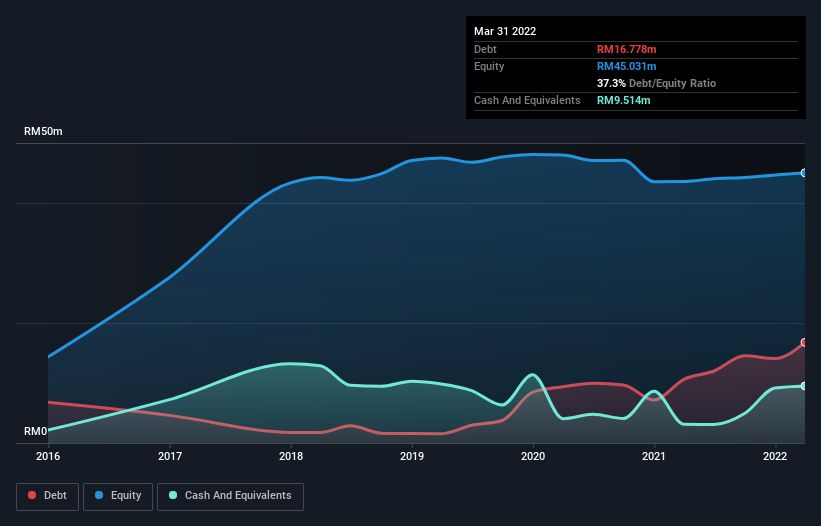- Malaysia
- /
- Commercial Services
- /
- KLSE:CABNET
Is Cabnet Holdings Berhad (KLSE:CABNET) Using Too Much Debt?
The external fund manager backed by Berkshire Hathaway's Charlie Munger, Li Lu, makes no bones about it when he says 'The biggest investment risk is not the volatility of prices, but whether you will suffer a permanent loss of capital.' It's only natural to consider a company's balance sheet when you examine how risky it is, since debt is often involved when a business collapses. Importantly, Cabnet Holdings Berhad (KLSE:CABNET) does carry debt. But the more important question is: how much risk is that debt creating?
Why Does Debt Bring Risk?
Debt and other liabilities become risky for a business when it cannot easily fulfill those obligations, either with free cash flow or by raising capital at an attractive price. Part and parcel of capitalism is the process of 'creative destruction' where failed businesses are mercilessly liquidated by their bankers. While that is not too common, we often do see indebted companies permanently diluting shareholders because lenders force them to raise capital at a distressed price. Of course, debt can be an important tool in businesses, particularly capital heavy businesses. When we think about a company's use of debt, we first look at cash and debt together.
See our latest analysis for Cabnet Holdings Berhad
What Is Cabnet Holdings Berhad's Net Debt?
The image below, which you can click on for greater detail, shows that at March 2022 Cabnet Holdings Berhad had debt of RM16.8m, up from RM10.6m in one year. However, because it has a cash reserve of RM9.51m, its net debt is less, at about RM7.26m.

A Look At Cabnet Holdings Berhad's Liabilities
We can see from the most recent balance sheet that Cabnet Holdings Berhad had liabilities of RM50.3m falling due within a year, and liabilities of RM10.1m due beyond that. Offsetting this, it had RM9.51m in cash and RM64.1m in receivables that were due within 12 months. So it can boast RM13.3m more liquid assets than total liabilities.
This surplus liquidity suggests that Cabnet Holdings Berhad's balance sheet could take a hit just as well as Homer Simpson's head can take a punch. On this view, lenders should feel as safe as the beloved of a black-belt karate master.
We measure a company's debt load relative to its earnings power by looking at its net debt divided by its earnings before interest, tax, depreciation, and amortization (EBITDA) and by calculating how easily its earnings before interest and tax (EBIT) cover its interest expense (interest cover). This way, we consider both the absolute quantum of the debt, as well as the interest rates paid on it.
Cabnet Holdings Berhad's net debt to EBITDA ratio of about 1.7 suggests only moderate use of debt. And its strong interest cover of 10.3 times, makes us even more comfortable. Although Cabnet Holdings Berhad made a loss at the EBIT level, last year, it was also good to see that it generated RM3.5m in EBIT over the last twelve months. There's no doubt that we learn most about debt from the balance sheet. But it is Cabnet Holdings Berhad's earnings that will influence how the balance sheet holds up in the future. So if you're keen to discover more about its earnings, it might be worth checking out this graph of its long term earnings trend.
Finally, while the tax-man may adore accounting profits, lenders only accept cold hard cash. So it's worth checking how much of the earnings before interest and tax (EBIT) is backed by free cash flow. Over the last year, Cabnet Holdings Berhad actually produced more free cash flow than EBIT. That sort of strong cash conversion gets us as excited as the crowd when the beat drops at a Daft Punk concert.
Our View
Cabnet Holdings Berhad's conversion of EBIT to free cash flow suggests it can handle its debt as easily as Cristiano Ronaldo could score a goal against an under 14's goalkeeper. And the good news does not stop there, as its interest cover also supports that impression! Overall, we don't think Cabnet Holdings Berhad is taking any bad risks, as its debt load seems modest. So the balance sheet looks pretty healthy, to us. When analysing debt levels, the balance sheet is the obvious place to start. But ultimately, every company can contain risks that exist outside of the balance sheet. For example - Cabnet Holdings Berhad has 2 warning signs we think you should be aware of.
At the end of the day, it's often better to focus on companies that are free from net debt. You can access our special list of such companies (all with a track record of profit growth). It's free.
New: AI Stock Screener & Alerts
Our new AI Stock Screener scans the market every day to uncover opportunities.
• Dividend Powerhouses (3%+ Yield)
• Undervalued Small Caps with Insider Buying
• High growth Tech and AI Companies
Or build your own from over 50 metrics.
Have feedback on this article? Concerned about the content? Get in touch with us directly. Alternatively, email editorial-team (at) simplywallst.com.
This article by Simply Wall St is general in nature. We provide commentary based on historical data and analyst forecasts only using an unbiased methodology and our articles are not intended to be financial advice. It does not constitute a recommendation to buy or sell any stock, and does not take account of your objectives, or your financial situation. We aim to bring you long-term focused analysis driven by fundamental data. Note that our analysis may not factor in the latest price-sensitive company announcements or qualitative material. Simply Wall St has no position in any stocks mentioned.
About KLSE:CABNET
Cabnet Holdings Berhad
An investment holding company, provides building construction and management solutions in Malaysia.
Adequate balance sheet with questionable track record.
Similar Companies
Market Insights
Community Narratives



